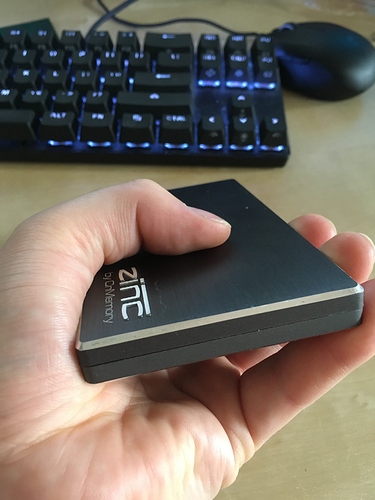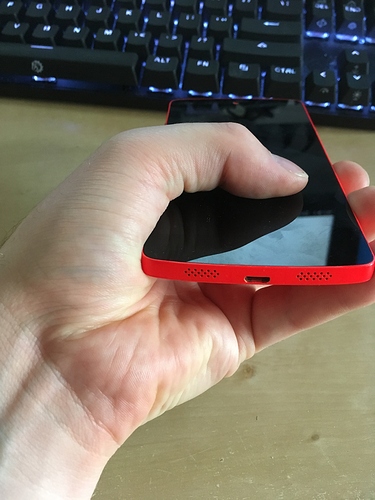What is the intended battery 's capacity ?
As big as possible 
The issue is that this will be a trade off between component sizes, overall device size and the battery size. The hardware designers are now working on two approaches and we need to see where they and up with.
How thick a device would you still accept? This is basically the biggest question here. Battery capacity is in direct proportion to its physical volume. The more capacity the more volume = space you need. Since we use modules for baseband and WiFi and these take up significant space and since we use the iMX8M which is not available as POP (package on package) our PCB will become pretty large. If you want to have the battery side by side with the PCB this leaves little room for the battery. That’s why are now looking into having the battery kind of sandwiched between display and PCB so that we have the full area for the battery. The capacity becomes a question of thickness only.
So how thick a device would be acceptable for you? 10mm? 11? 12? 15? 20?
You point out a number and we can basically tell which capacity this will result in - almost at least.
Cheers
nicole
Hello
the best phone I’ve had for battery life was elephone P5000 with 9.3 mm thick. But if the librem5 came to 15 mm to get a big battery I would still be happy
Antonio
P.S. obviously replaceable battery
Besides the thickness are you staying with the shape of the phone like presented in this design report?
With this flat back design with nearly no radius on the edges i would say below 15mm maybe 13mm!? max. A round back like the 3g iphone would allow for more thickness in the middle. I don’t think that’s an good option either. For design reasons on the on hand and i image round shapes to be more expensive for production and fitting components in more complicated on the other hand. So i’m all down for the current square design but think it make thickness a little more noticeable and crucial for handling.
From the drawings i estimated the size of the Librem 5 to 141,4mm x 66,7mm. I also have a nexus 5 sitting on my desk, which is 137.84 mm x 69.17 mm x 8.59 mm. Is comfortable to hold for me. I could imagine a little thicker wouldn’t hurt, especially with the 3mm less in width. For thickness handling i just garbed a external hard drive which is 14mm thick and 74mm wide and has edges like your design. This is really uncomfortable to hold. I wouldn’t use it. I think the increased with is doing a lot here but the thick edge on the palm under the thumb doesn’t feel great either. So re ensures me on the under 15mm statement more to the 12mm spec.
Good answer
imho, a thick smartphone is better than a device with large surface
yeah, can definitely double that. it’s what i meant with the width is probably hurting the usability more that the thickness.
What capacity can we expect from a 15 mm thick device ?
I think the absolute capacity is secondary.
I’d like it to have a week of standby, and a reasonable amount of time of actual usage.
Also, thickness is not the only limiting factor.
Weight increases quickly with each mm you add for a fullsize-battery.
It seems like most phones stay below 200g (7 ounces), some get close to 300g.
I’d like to stay closer to the 200g side 
12mm seems to be the thickest that i can imagine carrying around. 15mm or 20mm seems ridiculous.
I mean, we want to show this device to our friends and convince them that it’s much cooler than anything with iOS or Android on it.
“Look, there comes Johnny again, with that $600 brick in his pocket. Good privacy? Sure, never saw a brick with privacy issues.”
@nicole.faerber
i recently droped my pledge for the librem 5 device after i noticed that current design do not favor hot-swapable batteries.
imo the best basic smartphones i used and am currently using are the Blackberry pre 2013. q10 beeing the best overall. 3.1 rectangular screen 2100 ma/H hot-swapable battery, real keyboard buttons. all this is a package that fits this description.
119.6 x 66.8 x 10.4 mm (4.71 x 2.63 x 0.41 in)
Weight 139 g (4.90 oz)
https://www.gsmarena.com/blackberry_q10-5274.php#
what use is having hardware-kill-switches for the camera-mic-NIC if you can’t take the battery out quick and easy ?
the same issue currently with the 15v3 laptop. not everyone lives in USA and most of us have to rely on fast and easy replacements.
it’s AWESOME that you are using PureOS but ANY hardware design that doesn’t include hot-swapable batteries is a mess and much more of a hassle for end users.
you say you want to create a device that is easy to service and is not rendered remote-obsolete whenever a manufacturer deems it neccessary. So what are closed battery packs if not that ?
Pardon my ignorance
Is’nt standby time determined by battery power capacity ?
Sorry if you are disappointed.
We definitely will have a user replaceable battery. It will not be soldered to the board nor glued into the case. But it will involve some minutes of work and probably also some tools (screw driver) to replace it. So the obsolescence issue is limited or none.
Give the size constraints we have we have no other choice to not have it more easily removable. I somewhat agree that this would be the favorable solution but it would turn the mechanical design into a nightmare.
Cheers
nicole
Of course. In part.
standby_time = capacity / power_consumption
What I meant to say is:
You cannot judge if 2000mAh or 4000mAh is “good” if you don’t know how much energy it uses in standby (or regular use). It’s just a number.
If a 10mm phone would give reasonable standby (and use) time, I wouldn’t go thicker.
The consumption is, of course, not known exactly. It probably depends on the strength of the cell tower signal, and on how optimized all drivers are. A week standby is the minimum I expect, but two weeks wouldn’t hurt either 
Ultimately, it’s a blance between these: thickness/weight and capacity/endurance
That is good enough for me. Soldering I can also live with but gluing I really do not like. Long standby time is very desirable and if it means thicker and heavier phone - so be it …
i really am sorry too. if others can do it so can you. why would it turn into a nightmare if you have smart people employed ? if Blackberry did it 10 years ago with their hot-swapable batteries on their phones that means it can be done in laptops too.
laptops had good mechanical design when there were only plastic chasis around. what excuse is there now when you can do it after 10 years and after others have allready done it.
i can understand if it takes another couple years to do a decent job but don’t quit half way.
Blockquote
A week standby is the minimum I expect
Blockquote
“A week” refers to 24/7 or do you turn off your smartphone for the night ?
Are there really people who do that?  Of course 24/7.
Of course 24/7.
When my Galaxy S3 had a new battery, it had a standby time of (almost) a week (I didn’t play much with it). But some newer phones do much better here.
I might use a mode (if possible) that disables sensors and connectivity during the night.
The main reason why we are so space limited is that we use a pretty different hardware architecture compared to current smartphones. These use combined chipsets, like the Snapdragon etc., which include most of all the radios in one chip, including the main CPU. They are also mostly available as package on package which saves additional PCB space.
We do not have all that at hand so our PCB space needed for all the components is at least three times higher. This ends up with a PCB design which covers most of the device surface leaving no place for a battery side by side with the PCB. So you could propose, well, then put the battery on top of the PCB directly under the back cover? This does not work either because of thermal problems. The components would heat up the battery which in turn is not good for the battery.
So you now hopefully understand that we do not have much choice.
Cheers
nicole
For me, the ideal thickness would be 11mm, up to a maximum of 18mm.
I would start at 11mm and then increase the thickness until either the battery capacity is, let’s say, equivalent to 12 continuous hours of non-hardware-accelerated video streaming; or the thickness reaches 18mm; whichever comes first.
I do think a bit of an edge bevel/chamfer/radius is important for comfort, but the design mock-ups I’ve seen look OK. Presumably someone will test this aspect anyway.
I’m happy with an internal, replaceable battery if the capacity is high enough for day-to-day use. Don’t forget to provide a way to do a hard (or firm) reboot without removing the battery! The supplied software might be pretty stable, but if I’m free to run whatever I want on this thing I’m moderately likely to crash it at some point!
I still prefer removable batteries in laptops though.
ok, I’m sure you’ll find the best possible solutions.
good job
@nicole.faerber
i apologise if i came down to hard.
you were refering to the librem 5 i wasn’t.
i’ve been informed of your current hardware challenges with the librem 5 and i knew it wasn’t going to be possible to make such drastic design changes this late in the design process. i wasn’t expecting what i complained about with the librem 5 nor with the librem 15 v3 or v4 … but maybe the next iterations of hardware design can be altered in a more meaningfull way … but that is a few years at least if all goes well.
i really hope everyone will be rewarded for their patience !


